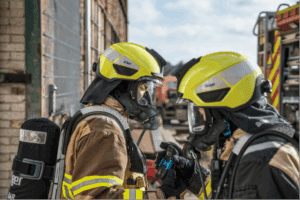Dave Pelton, Vice President of Global Marketing at Solberg, explains how the use of fire-fighting foam has grown, and the advantages it can bring
Use of foam has often been a confusing and largely misunderstood fire-fighting tactic within the fire service. To a large extent, many municipal fire services have historically avoided the use of fire-fighting foam, especially Class A foam concentrates, because of the perceived high cost of buying and using the product. However, when looked at from a more holistic perspective, the use of foam may actually lower overall cost when compared to using water only. So where do we start?
What is Class A foam?
Developed in the mid-1980s, Class A foam was predominately used for wild-land fires, but as their popularity grew throughout the 1990s the use of Class A foam was expanded for use on structural fires.
Class A fires consist of ordinary combustible materials such as paper, cloth, wood, and plastics. These type fuels require the heat-absorbing effects of water (cooling) or water solutions. Class A fires consist of two types. The first type is flaming combustion involving gases that result from the thermal decomposition of the fuel. The second type is deep-seated or glowing. This type represents combustion within the mass of the fuel and has a slow rate of heat loss and a slow rate of reaction between oxygen and fuel.
As a synthetic-based foam concentrate, Class A foam is applied at low concentrations ranging from 0.1% to 1.0% (see proportioning rates below). Cooling and wetting are the primary extinguishing mechanisms. The use of Class A foam makes ‘water wetter’, on average increasing the effectiveness of water tenfold.
Exposure Protection: 1.0%
Fire Brake: 0.75%
Initial Suppression: 0.5%
Overhaul: 0.25%
These proportioning rates make the use of Class A foam a cost-effective means of combating fires because smaller amounts of foam concentrate can be used to make effective foam. Class A foam is biodegradable and non-toxic, so it is environmentally sustainable. Class A foam is deployed through a variety of portable and fixed appliance devices ranging from fire-fighters’ backpacks, brush and fire apparatus, to rotary and fixed-wing aircraft.
Using foam actually reduces costs
Many rural and small urban fire service departments already have embraced the use of Class A foam as part of their everyday operational tactics. Their use of Class A foam simply makes good sense for them. For any department that has to bring their water to the scene and has to establish water tanker shuttles, using Class A foam easily can reduce their actual cost of fighting the fire. The reason? Class A foam, when properly deployed, allows the fire to be extinguished more quickly and with far less water than would be required if it were not used. On average, the use of Class A foam increases water’s wetting capability tenfold. In more simplified terms…’making water wetter’. In addition, the amount of time required post-extinguishment during overhaul or mop-up is greatly reduced. Quite simply, the crew extinguishes the fire more quickly and returns to the station faster so total man-hours on the scene are greatly reduced. Additionally, there is less wear and tear on equipment as there are fewer tanker shuttles required to get the job completed.
“The use of fire-fighting foam by the fire service is not a single extinguishing solution, rather a tool (amongst many tools) that when combined with tactics creates a more efficient operational scenario,” states Ed Janke, Director of Public Safety – Howard (WI) Fire Department. A Chief Officer with more than 25 years in the fire service, Chief Janke is a graduate of the National Fire Academy’s Executive Fire Officer Program and former Associate Dean of Public Safety at the academia level. He instructs all levels of Incident Command courses, including Command and General Staff as well as management related topics such as leadership, organisational assessment, risk management and strategic planning.
“Our department has utilised both Class A and B foams for more than 30 years and Compressed Air Foam Systems (CAFS) for more than ten years with tremendous success,” says Chief Janke. With the introduction of CAFS some departments have taken the approach believing they could reduce water consumption (lpm), but the reality is, whether using CAFS or traditional foam application appliances like line eductors or foam nozzles, water still is needed to suppress fire.“It’s all about creating the right conditions in the compartment to control the fire safely,” Chief Janke goes on to say. “The use of foam, like air flow management, is a force multiplier that when employed with traditional tactics stabilises the fire hazard, thus allowing personnel to enter the structure for overhaul.” While there are costs associated with the use of foam, be it advancements in system hardware technology or the foam concentrate itself, the use of fire-fighting foam—Class A foam in particular—is an asset the municipal fire service should not overlook for structural protection. “Over the 25 years I have been associated with the fire service, the single biggest eye opener for the use of Class A foam is zero lot line properties or apartment buildings where the likelihood of multiple exposures or rather fire scenarios is high. The ability to use foam for both internal and external exposure protection and simultaneous active fire suppression is an extremely valuable resource for us in the fire service,” says Chief Janke.
While the use of Class A foam by departments who have to carry water with them is quite obvious, the same factors that make it desirable for these departments carries through to larger municipal departments with well-established water hydrants and supplies. Water is not free. No matter how you look at it, the cost to transport water to the fire scene is a large factor in total cost. For the rural departments who have to carry water with them, the cost comes about through the equipment and the manpower required to run the tanker shuttles. For the departments with an established hydrant system, the cost comes about through the development and maintenance of the water mains and hydrants. In fact, the cost to develop and maintain this type of infrastructure may exceed the cost of transporting via tankers. Beyond the cost of the water infrastructure, the rest of the manpower advantages continue. Again, less time spent at the fire scene for extinguishment and overhaul means less total cost.
This is even more important in drought prone areas where judicious use of water resources by both the general public and fire service needs to be considered. Here again, use of Class A foam allows the fire service to minimise the impact of fire-fighting operations with respect to total amount of water available.
Another advantage in using Class A foam is that lower nozzle flow rates can be used. Fire flow rates can easily be reduced by half, or more, when Class A foam is deployed. This brings with it the advantage of being able to use smaller pumper trucks and less total manpower staffing. Obviously, smaller pumpers mean less initial cost and more efficient use of staff resources. It also translates into lower overall operating and maintenance expenses. Recent developments in Compressed Air Foam (CAF) Systems technology and in Ultra High Pressure (UHP) foam delivery equipment further enhance the ability to use lower fire flow rates.
Wetting agents and emulsifiers – alternative products?
The use of fire-fighting wetting (mid 1960s) and emulsifying (early 1990s) agents were introduced to the fire-fighting community claiming use on Class A and B fires. The goal of these alternative agents is similar to foam agents in that they aim to reduce the surface tension of water. However, instead of forming a ‘foam blanket’ on a Class B fuel surface, the solution is ‘vigorously’ mixed with the fuel to form a non-flammable emulsion. Emulsifiers have limited foaming capabilities. They must be mixed with water at a given percentage and ‘forcefully applied’ onto the entire surface of the burning fuel source. The resulting solution then mixes with the fuel, breaking it into very small droplets (the definition of an emulsifier). These droplets of fuel are surrounded or encapsulated by the emulsifier/water mixture to extinguish the fire.
The Underwriters Laboratories Inc. (UL) Directory defines wetting agents as “liquid concentrates which, when added to plain water in proper quantities, materially reduce the surface tension of plain water and increases its penetration and spreading ability.” Water to which a wetting agent has been added is sometimes referred to as ‘wet water’ because of its increased ability to wet surfaces where it is applied. Wetting agents improve the efficiency of water in extinguishing Class A fuel fires. Use on Class B combustibles requires much higher application rates than those requiring foam agents, and is limited to non-water soluble flammable liquids (hydrocarbons only). Little, if any, burn-back resistance is present on Class B fires extinguished with “emulsifiers or wetting agents.”
Use of emulsifiers or wetting agents does not afford use as a “fire brake or passive structural protection” (i.e. exposure protection). In contrast to Class A foam, the use of wetting agents and emulsifiers does not provide adequate exposure protection against radiant heat or an advancing fire. A note of caution: Class A foam, wetting agents or emulsifiers never should be used on Class E (energised electrical) Class D (combustible metals), or Class F (cooking oils) fires as the water content in these products is not compatible with the fuel hazard.
In conclusion, the use of Class A foam just makes smart sense. It enhances the municipal fire service’s ability to suppress fires more rapidly. It improves water’s wetting capability thereby providing faster penetration and greater fire control. It also increases protection of personnel and minimises operational costs through the use of variable proportioning rates, thus minimising post-fire clean-up time, and conserving valuable water resources.
Author Bio
Dave Pelton is Vice President of Global Marketing for The Solberg Company. Dave entered the fire protection industry in 1984 and has served on several trade association board of directors and industry technical committees on both a domestic and international level including Fire Equipment Manufacturers Association (FEMA), Fire Suppression Systems Association (FSSA), National Fire Protection Association (NFPA), and International Standards Organisation (ISO) where he is a current member of the U.S. TAG for TC21/SC6 – Fire Extinguishing Media Foam Concentrates and Systems Hardware.




































